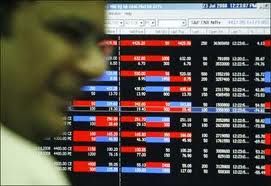 | « Back to article | Print this article |
 Smart traders try to stay out of non-trending, fast changing markets.
Smart traders try to stay out of non-trending, fast changing markets.
Note that a range-trading market may not be choppy.
If a stock predictably moves to the top of a defined range, hits resistance and drops back down to the bottom of the range where it hits support, it can be traded.
For example, a stock, which oscillates between 100 and 110, displays a range trading pattern, which can be handled with stops at say, 99 and 111.
In this instance, the stock sees an uptrend and a downtrend and a trader could go long and short, while setting stops at the top and bottom of the range.
However, when prices change direction fast and unpredictably we cannot rely on range trading patterns to hold.
Another way of putting it is that the range is too small to be comfortably traded.
For example, a stock may oscillate between 100 and 102 and back down to 100 again.
In those circumstances, there are some things the trader can do, apart from waiting for some sign of predictability to develop.
One trick is to vary the time frame.
A pattern may show up on a shorter time frame, or a longer one.
The trader may discover for example, that the 100-102 pattern is predictable if he’s operating with five-minute bars.
Or, he may discover that the long-term pattern is bullish or bearish, while ignoring the relatively small fluctuations.
Point and figure charts with a small box size can also sometimes offer useful signals in choppy markets.
Some traders use tools like the Average Directional Index to see if there is an underlying trend when prices are choppy.
The ADX is a combined indicator, included in most trading software.
It compares latest high to previous high and latest low to previous low to see if there’s a positive trend or negative trend.
Both a positive and a negative trend can exist together (current low may be lower than previous low and current high higher than previous high).
These values are smoothed and normalised by calculating respective moving averages and then dividing by a smoothed measure of high-low range.
After this, the absolute value of the difference between the positive and negative trends is divided by the absolute value of the sum of the two trends to yield a number, which is somewhere between 0 and 100.
A high ADX indicates a strong trend while a low ADX indicates a weak trend.
However, ADX doesn’t indicate trend direction.
But direction can be discerned by comparing positive to negative trends.
Some traders look for crossovers in the positive versus negative trends and use those as signals.
ADX can be used as a confirmatory signal or a red flag.
However, my sense is that if a price-trend cannot be discerned visually, by shifting time frames if necessary, complicated tools like ADX are rarely reliable. ADX signals are usually visible on the price chart itself.
The author is a technical and equity analyst